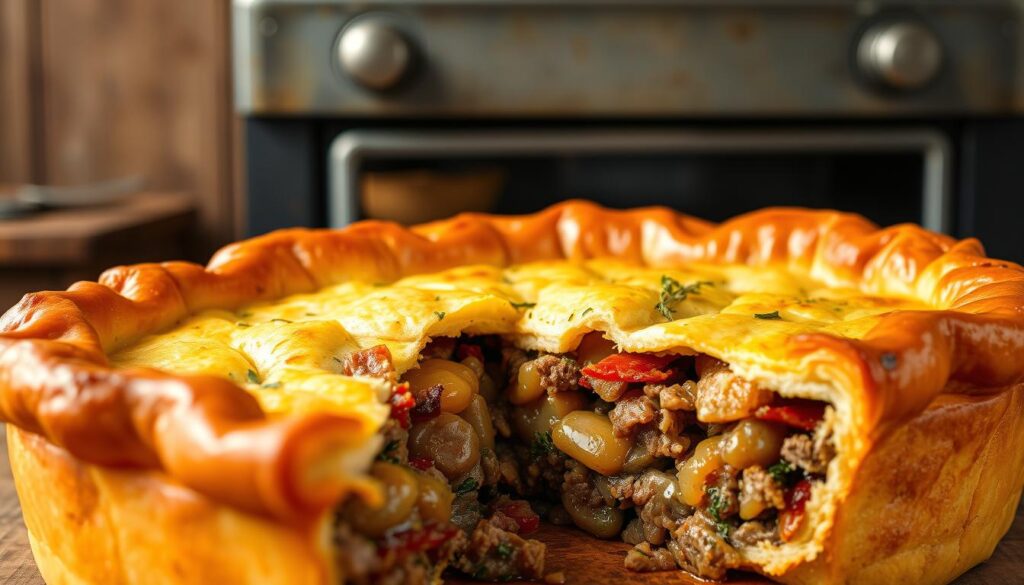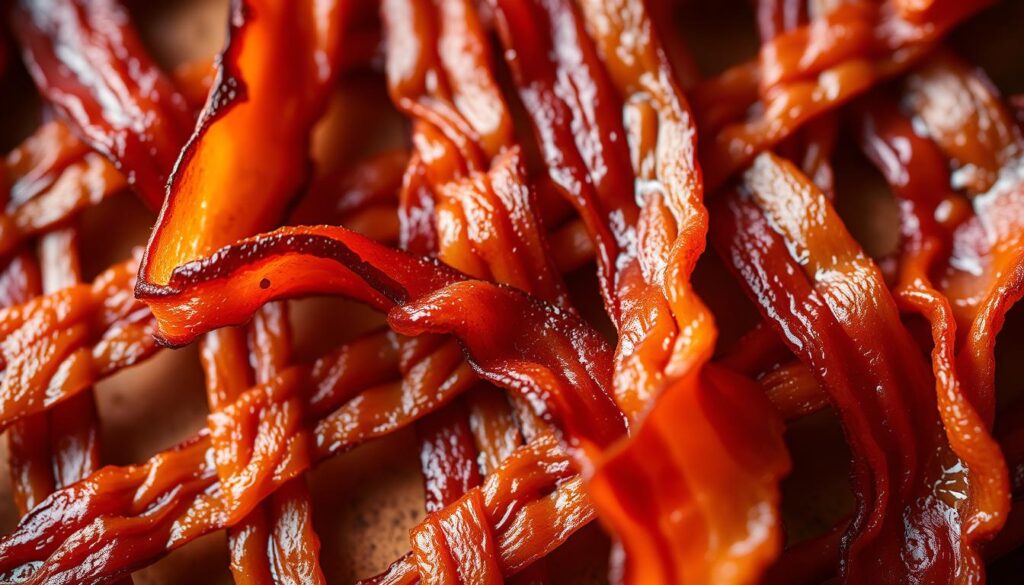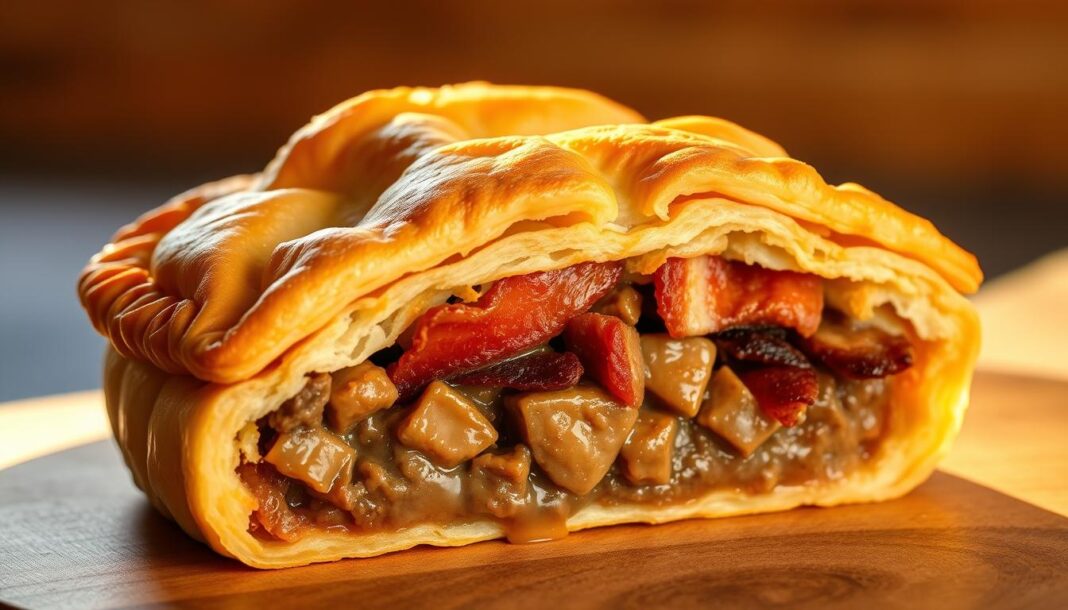The art of crafting the perfect meat pie is a culinary challenge that many home cooks and professional bakers alike aspire to master. At its core, a great beef and bacon pie combines tender chunks of beef, crispy bacon, and savory vegetables encased in a flaky pastry crust.
We’ve seen a resurgence in the popularity of this dish, partly due to its connection to the hit series Game of Thrones, where it’s featured as a Winterfell delicacy, often referred to in the context of a “feast” or associated with the phrase “ice fire.”
Whether you’re a seasoned baker or attempting your first pie, our comprehensive guide will walk you through the process, from selecting quality ingredients to achieving the perfect filling consistency and mastering the signature bacon lattice.
Key Takeaways
- Learn how to select the best ingredients for your beef bacon pie
- Master the technique of creating a flaky pastry crust
- Discover the secret to achieving the perfect filling consistency
- Understand how to create a visually stunning pie with a bacon lattice
- Explore the cultural significance of meat pie in culinary traditions
The Rich Heritage of Beef and Bacon Pie
The allure of beef and bacon pie lies in its hearty, comforting nature, a trait that has captivated audiences from the Stark children in “A Game of Thrones” to modern-day food enthusiasts. This dish, deeply rooted in medieval cuisine, has evolved over time, influenced by various culinary traditions.

A Winterfell Delicacy: Game of Thrones Connection
The beef and bacon pie gained significant popularity through its prominent mention in George R.R. Martin’s “A Game of Thrones” series. In the fictional world of Westeros, this hearty dish represents comfort and home, particularly associated with the Stark family’s northern stronghold of Winterfell. As Jon Snow yearned for “Gage’s beef-and-bacon pies,” it underscored the pie’s role as a nostalgic comfort food.
Modern vs. Medieval Versions
While medieval versions of beef and bacon pie included dried fruits like raisins and prunes, creating a sweet-savory profile, the modern version emphasizes savory flavors with beef, bacon, vegetables, and herbs. The evolution of this pie reflects changing culinary sensibilities, as seen in “A Feast of Ice and Fire,” a cookbook that offers both medieval and modern interpretations. This transition highlights the adaptability of the dish while maintaining its core identity as a comforting, satisfying meal perfect for cold climates.
Our modern beef and bacon pie recipe stays true to the spirit of its medieval ancestors while incorporating contemporary tastes, making it a unique culinary experience that bridges past and present.
Essential Ingredients for the Perfect Beef and Bacon Pie
The foundation of a mouth-watering beef and bacon pie lies in its essential ingredients. To create a truly satisfying dish, it’s crucial to select the right components. We will explore the key elements that make up this savory pie.
Selecting Quality Meat Cuts
Choosing the right cut of beef is vital for a successful pie. We recommend using 1½ pounds of chuck steak or stew meat, cut small into approximately ½-inch cubes. This cut provides a perfect balance of fat and lean tissue, becoming tender and flavorful during the slow cooking process. Quality bacon is also essential, forming the foundation of the dish’s distinctive flavor profile. Opt for thick-cut bacon with a good ratio of fat to meat for the best results.
The Vegetable Base
The vegetable base typically consists of onions, carrots, and potatoes, which provide texture contrast and absorb the savory meat flavors while cooking. To prepare the vegetables, dice 1 onion, cut 1 carrot into small chunks, and cube ½ medium potato. Cooking these vegetables in butter – we use 2 tablespoons of unsalted butter – adds richness and helps develop the golden color on the onions, contributing depth of flavor to the filling.
Pastry Dough Considerations
The pastry dough requires careful consideration, as it must be sturdy enough to hold the filling without becoming soggy, yet tender enough to provide a pleasant eating experience. Flour forms the backbone of the pastry, while cold butter creates the flaky texture that contrasts beautifully with the rich filling. For a single-crust 9-inch pie, use ½ batch of Medieval Pastry Dough, or enough dough for the task, unbaked. For more detailed instructions on making the pastry dough, you can refer to a reliable recipe source, such as The Spruce Eats.

Creating the Signature Bacon Lattice
Elevate your beef and bacon pie with a beautifully woven bacon lattice, a true showstopper. The signature bacon lattice is what elevates this pie from a standard meat pie to a showstopping centerpiece, combining visual appeal with additional flavor.

Weaving Techniques for Beginners
To create the lattice, start by selecting 12 strips of bacon and arranging them on a clean work surface. The weaving technique involves laying half the strips parallel to each other, then lifting alternate strips to weave perpendicular bacon strips through, creating the classic over-under pattern.
- Begin with parallel strips, then weave others through.
- Make your lattice as wide as you can, reserving any extra strips.
- The lattice should be slightly larger than your pie plate.
Pre-Cooking Tips for Crispy Results
Pre-cooking the bacon lattice is essential to prevent excess grease from making the pie soggy during baking. Place the woven bacon on a baking sheet lined with parchment paper and bake in a preheated oven at 400°F for 15 to 20 minutes, or until it’s partially cooked but still pliable.
- Bake the lattice for 15-20 minutes until crispy.
- Transfer the cooked lattice to paper towels to drain excess fat.
- Any trimmed bacon pieces can be chopped and added to the filling.
Step-by-Step Beef and Bacon Pie Recipe
To make the perfect beef and bacon pie, follow our detailed, step-by-step recipe. This guide will walk you through the essential steps to create a delicious and savory pie that will impress your family and friends.
Preparing the Savory Filling
The foundation of a great beef and bacon pie lies in its filling. Start by melting butter in a large pan over medium heat. Add diced onion, carrot chunks, and cubed potato, cooking gently until the onion becomes soft and develops a golden color, typically taking about 5-7 minutes. While the vegetables cook, toss beef chunks with all-purpose flour until each piece is evenly coated, which helps thicken the filling and seal in the meat’s juices.
Add the flour-coated beef to the vegetable mixture and cook over low heat for approximately 5 minutes until the meat browns. Be careful not to overcook, as it will continue cooking in the oven. Incorporate any remaining flour into the pan and cook for an additional minute to eliminate the raw flour taste before adding liquid. Pour in beef broth along with salt, pepper, and dried rosemary, then simmer the mixture for 10 minutes until a gravy forms with the perfect consistency.
- Cook the vegetables until they’re soft and golden.
- Toss beef with flour to coat evenly.
- Simmer the mixture to form a rich gravy.
Assembling the Pie
Allow the filling to cool completely before assembling the pie, as hot filling can make the pastry dough difficult to work with. Roll out your pastry dough to approximately 1/8-inch thickness and carefully line your pie pan, allowing excess to drape over the edges. Pour the cooled filling into the pastry-lined pan, then top with your pre-cooked bacon lattice, trimming as necessary to fit.
Fold the overhanging pastry over the edges of the lattice to create a sealed edge. This not only adds to the pie’s aesthetic appeal but also ensures that the filling remains enclosed during baking.
Baking to Golden Perfection
Bake the pie in a preheated 400°F oven for approximately 40 minutes, or until the crust achieves a beautiful golden color. The baking time may vary depending on your oven, so keep an eye on the pie during the last 10 minutes to prevent over-browning.
The result will be a perfectly cooked beef bacon pie with a crispy, golden crust and a savory, flavorful filling.
Troubleshooting Common Beef and Bacon Pie Challenges
Crafting the perfect beef and bacon pie can be a complex process, with several potential pitfalls along the way. Despite careful planning, issues such as a soggy bottom crust, inconsistent filling, or structural problems can arise, affecting the overall quality of the pie.
Preventing a Soggy Bottom
One of the most common challenges when making beef and bacon pie is preventing the dreaded “soggy bottom” – a pastry base that becomes wet and undercooked from the filling’s moisture. To combat this, we recommend blind baking the pastry shell for 10-15 minutes before adding the filling. This creates a moisture barrier and ensures a crisp base. By doing so, you’ll achieve a well-cooked crust that complements the savory filling.
- Blind baking: Pre-bake the pastry shell before adding the filling.
- Moisture control: Monitor the filling’s consistency to prevent excess moisture.
Achieving the Perfect Filling Consistency
The filling consistency is crucial – too thin, and it will soak into the crust; too thick, and the pie becomes dense and stodgy. To achieve the perfect consistency, we recommend careful attention to the flour-to-liquid ratio during preparation. Aim for a thick stew-like consistency that holds together when spooned. If the filling seems too watery, continue cooking uncovered to reduce excess moisture, or add a small amount of cornstarch slurry to thicken it.
Fixing Structural Issues
Structural issues often occur when the pie crust isn’t properly sealed at the edges, allowing steam to escape and potentially causing the filling to bubble over. To prevent structural failures, ensure the top and bottom crust are firmly sealed by crimping the edges together. Cut small vents in the top crust (or between the bacon lattice) to allow steam to escape in a controlled manner. Temperature control is also crucial – starting with a hot oven (400°F) helps set the structure quickly.
- Seal the edges: Crimp the top and bottom crust together.
- Vent the pie: Cut small vents in the top crust to allow steam to escape.
Serving and Pairing Your Homemade Beef and Bacon Pie
Now that you’ve mastered the art of making a beef and bacon pie, let’s dive into the best ways to present and pair it. Your freshly baked beef and bacon pie can be enjoyed in various settings, whether it’s a comforting dinner or a picnic.
For an elegant presentation, slice the pie carefully to showcase the layers of golden crust, rich filling, and the decorative lattice on top. Traditional accompaniments include steamed seasonal vegetables and a simple green salad.
When it comes to beverage pairings, consider a robust red wine like Cabernet Sauvignon or a brown ale to complement the beef and bacon flavors. Leftover pie can be refrigerated for up to three days or frozen for future meals. Reheat in a 350°F oven until warmed through.


